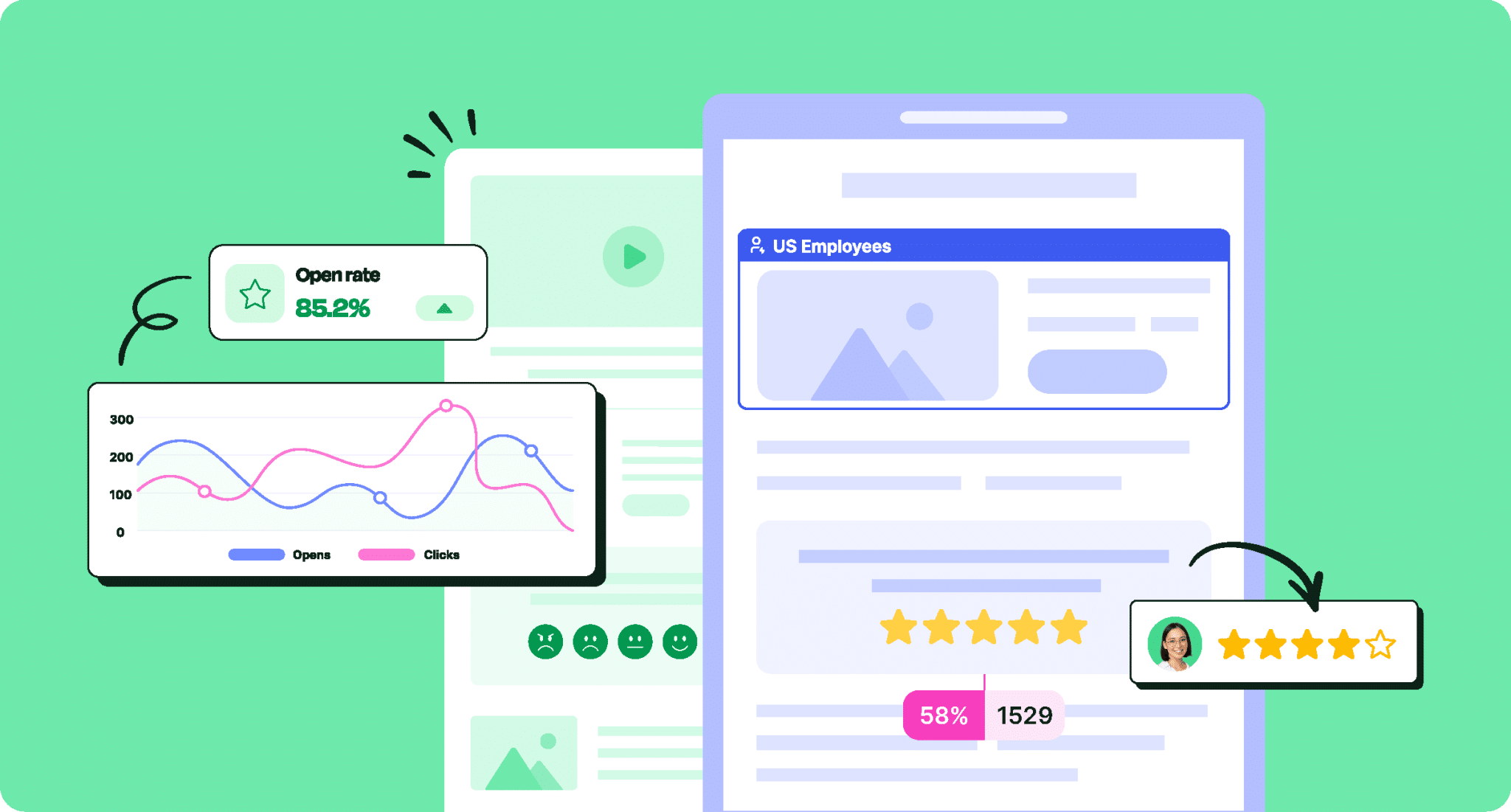In the era of The Great Detachment, employees are feeling more disconnected than ever—disengaged from their work, uncertain about their future, and increasingly adrift in a world filled with noise and uncertainty. Read along to learn about how to improve employee engagement in the workplace as an internal comms or HR leader.
As Gallup reports, many people today feel stuck, lacking a clear sense of purpose or direction in both their personal and professional lives. In the face of this emotional and cultural turbulence, the workplace has a unique opportunity to serve as a stabilizing force—a place where employees can reconnect with meaning, community, and a shared sense of belonging.
Internal comms leaders who intentionally foster the conditions for employee engagement can create that much-needed source of stability and a place to belong to. And, that sense of belonging is one of the core dimensions that improved employee engagement hinges on.
This blog explores how to improve employee engagement in the workplace by sharing 10 practical, people-first strategies that internal communicators and HR leaders can use to build trust, promote purpose, and create the kind of culture people want to be a part of.
Revive employee engagement with targeted, interactive emails and newsletters
Book a 15 minute call with one of our team members
What Does Employee Engagement Look Like in 2025?
Today’s employees aren’t just looking for a paycheck. They want to be part of something bigger than themselves. They want their work to matter.
Improved employee engagement comes from a deep belief in the organization’s mission and values. When people understand how their contributions drive real impact, they feel empowered, motivated, and genuinely proud to show up every day.
But purpose alone isn’t enough.
Employees also need to trust the people leading them. Trust in leadership is a foundational pillar of engagement—it builds psychological safety, reinforces transparency, and fosters a culture where people feel heard, valued, and supported.
Without trust, even the best engagement strategies fall short.
Why Is Employee Engagement Important?
When employees are engaged, the entire organization benefits—from the inside out. Here’s a breakdown of the most impactful benefits of improved employee engagement:
- Lower turnover: Engaged employees are more likely to stay, reducing the high costs of recruitment, onboarding, and lost productivity.
- Decreased burnout: Engaged teams report lower stress levels and better energy management, helping prevent burnout and long-term fatigue.
- Greater employee commitment: When people believe in their work and feel valued, they’re more committed to the organization’s mission and goals.
- Improved collaboration: Engaged employees are more likely to support teammates, share knowledge, and contribute to a more unified workplace.
- Increased sales: Motivated, customer-focused employees naturally drive stronger sales and conversion rates.
- Better employee health: Engaged teams tend to report better overall well-being, which reduces absenteeism and long-term health-related costs.
In short, improving employee engagement has far-reaching benefits that directly impact the bottom line.
What Are the Key Drivers of Employee Engagement?
Before diving into strategies to improve employee engagement, it’s helpful to understand the drivers that influence it most:
- Clear communication
- Recognition and appreciation
- Career development opportunities
- Trust in leadership
- Work-life balance
- Purpose and alignment with company values
- Employee voice and feedback loops
By focusing on these drivers, internal comms and leadership can create effective and sustainable ways to improve employee engagement in the workplace.
How much is low employee engagement costing you?
Measure your internal comms ROI
10 Best Ways to Improve Employee Engagement in the Workplace
Here are 10 powerful employee engagement strategies for 2025, each with practical tips and tools you can implement right away.
1. Prioritize transparent and frequent internal communication
One of the most effective strategies to improve employee engagement is clear, consistent, and transparent communication. Employees want to know what’s happening, why it matters, and how they fit into the bigger picture.
Here’s what can happen if this element is lacking:
- Employees feel confused, isolated, and disconnected from company goals.
- Misinformation and rumors can spread in the absence of clarity.
- A lack of transparency erodes trust in leadership over time.
How to improve employee engagement through communication:
- Send regular internal newsletters with company updates, team wins, and strategic goals.
- Share leadership communication updates using segmented internal emails to reach the right audiences with the right messages.
- Open anonymous feedback channels to give employees a safe space to voice concerns or suggestions.
Actionable examples:
- Launch a weekly “Friday Wrap-Up” email with leadership insights and employee highlights.
- Add a recurring “You Said, We Did It” section in newsletters to close the loop on feedback.
- Share short video messages from leaders explaining company priorities in plain language.
Tips for execution:
- Avoid corporate jargon—use conversational language to increase relatability and understanding.
- Use dynamic content blocks to personalize messages by department or role.
PRO TIP: Use our Analytics features and Employee Feedback features to see which messages resonate most and gather feedback in real time—without leaving Outlook or Gmail.
2. Offer flexible work options and support work-life balance
The modern workforce values autonomy and flexibility. Creating a culture that respects personal time and promotes balance is one of the most impactful ways to improve employee engagement.
Here’s what can happen if this element is lacking:
- Burnout increases and morale drops due to rigid or unrealistic work expectations.
- Employees may feel micromanaged or mistrusted.
- Top talent will seek more flexible opportunities elsewhere.
How to improve employee engagement through flexibility:
- Provide remote or hybrid work options when possible.
- Allow flexible hours to accommodate different schedules and life stages.
- Encourage regular breaks and normalize taking time off for mental health.
Actionable examples:
- Introduce “Flex Fridays” with reduced meetings and optional work hours.
- Offer floating wellness days that employees can use at their discretion.
- Feature employee stories about how flexibility helps them thrive inside and outside of work.
Tips for execution:
- Set clear expectations and guidelines around availability and performance to maintain consistency.
- Use scheduling tools to coordinate team workflows and prevent burnout.
PRO TIP: Promote work-life balance policies through internal emails using our recurring internal email templates, thanks to the Email Builder feature — so employees are regularly reminded of available support.
Employee emails that drive engagement
Build engaging internal emails in just a few clicks. Drag, drop, done!
3. Recognize and celebrate employee achievements
Recognition reinforces positive behaviors, boosts morale, and strengthens loyalty. Making employees feel valued is a simple yet powerful way to improve employee engagement in the workplace. Plus, you can make recognition fun with these employee recognition ideas!
Here’s what can happen if this element is lacking:
- Employees feel unseen and undervalued.
- Motivation drops, especially among high performers.
- A lack of recognition contributes to disengagement and higher turnover.
How to improve employee engagement through recognition:
- Celebrate wins publicly in internal communications.
- Encourage peer-to-peer recognition through dedicated shoutout sections.
- Tie recognition to company values to reinforce purpose and alignment.
Actionable examples:
- Feature a “Team Member of the Month” with a short spotlight in your newsletter.
- Introduce a peer-nominated recognition program with digital badges or certificates.
- Create a “Win Wall” in your internal email showcasing team and individual accomplishments weekly.
Tips for execution:
- Make recognition timely—don’t wait weeks to acknowledge great work.
- Include both individual and team achievements to encourage collaboration.
4. Encourage two-way communication and feedback
Two-way communication and the creation of open feedback loops are key to improving employee engagement. Employees want to know their opinions matter—and that their voices lead to visible changes.
Here’s what can happen if this element is lacking:
- Employees feel ignored and disengaged.
- Workplace issues go unaddressed and escalate.
- A culture of silence develops, reducing innovation and trust.
How to improve employee engagement through feedback:
- Conduct regular employee engagement surveys and pulse checks.
- Host skip-level conversations and company-wide town halls.
- Communicate the outcomes of feedback and the actions being taken.
Actionable examples:
- Embed one-click polls in internal emails to capture real-time sentiment.
- Host a monthly “Voice of the Employee” spotlight where selected feedback is shared anonymously (with permission), along with leadership responses.
- Launch a suggestion box campaign with weekly follow-ups on submissions.
Tips for execution:
- Keep surveys short, focused, and easy to complete across devices.
- Always close the loop—employees need to see that their input is valued and acted upon.
BONUS: Looking for different options to include surveys in emails? Check out our comprehensive article on how to use surveys in internal email.
Pulse surveys that actually engage employees
Get instant feedback with our interactive survey tools—without switching platforms.
5. Provide career growth and development opportunities
When employees see a clear path for growth, their motivation and engagement rise. Development is one of the most reliable strategies to improve employee engagement long-term.
Here’s what can happen if this element is lacking:
- Employees feel stuck or stagnant in their roles.
- High-potential talent will seek development opportunities elsewhere.
- A lack of growth leads to disengagement and complacency.
How to improve employee engagement through growth:
- Offer structured career development plans.
- Provide access to training, mentorship, and cross-training opportunities.
- Celebrate internal mobility and success stories.
Actionable examples:
- Create a monthly “Career Growth Corner” in your newsletter featuring learning opportunities.
- Launch an internal job board or promotion tracker to increase transparency.
- Highlight career path spotlights showing how employees advanced internally.
Tips for execution:
- Use employee surveys to identify skill gaps or development interests.
- Track participation in training programs and follow up with progress check-ins.
PRO TIP: Use our List Management and Dynamic Content feature to promote development opportunities by department, role, or seniority level.
6. Empower managers to lead with empathy, hope, and clarity
Gallup’s global research shows that hope is one of the top four things employees need most from their leaders, alongside stability, trust, and compassion. When managers lead with empathy and communicate a hopeful vision of what’s ahead, they create a stronger sense of purpose and resilience among their teams. This approach is central to improving employee engagement in a lasting, meaningful way.
Here’s what can happen if this element is lacking:
- A lack of hope fuels apathy, resistance to change, and emotional withdrawal.
- Poor management leads directly to disengagement and attrition.
- Employees are unclear on expectations, leading to stress and confusion.
How to improve employee engagement through leadership:
- Train managers in emotional intelligence and inclusive leadership.
- Encourage consistent 1-on-1s and regular team check-ins.
- Support managers with clear, timely internal communication materials.
Actionable examples:
- Share a monthly “Management Toolkit” and change management training via email with templates and coaching tips.
- Run a series of bite-sized video trainings for people leaders.
- Create a “Manager Kudos” section in your newsletter spotlighting outstanding leadership.
Tips for execution:
- Recognize and reward empathetic leadership behaviors.
- Collect employee feedback about manager effectiveness regularly.
7. Build a workplace culture of belonging and inclusion
A culture where every employee feels seen, safe, and valued is critical to improving employee engagement. Belonging fuels trust, collaboration, and commitment.
Here’s what can happen if this element is lacking:
- Employees may feel isolated, unseen, or unwelcome.
- Underrepresented groups may disengage or leave.
- Innovation and collaboration suffer in non-inclusive environments.
How to improve employee engagement through inclusion:
- Actively involve ERGs (employee resource groups) in company decisions.
- Celebrate diverse voices, perspectives, and lived experiences.
- Ensure all employees feel represented in internal content.
Actionable examples:
- Feature “Employee Stories” in your internal newsletter spotlighting diverse experiences.
- Promote DEIB (diversity, equity, inclusion, and belonging) events via segmented emails.
- Run an “Inclusion Check” pulse survey quarterly to track sentiment.
Tips for execution:
- Use inclusive language and imagery in all comms.
- Partner with ERGs to co-create inclusive communications.
8. Create opportunities for cross-team collaboration
Collaboration builds camaraderie and breaks down silos. Encouraging interdepartmental connection is a proven way to improve employee engagement in the workplace.
Here’s what can happen if this element is lacking:
- Silos form, limiting knowledge sharing and team synergy.
- Employees miss out on opportunities to build new relationships and learn.
- Engagement suffers as people feel disconnected from broader company efforts.
How to improve employee engagement through collaboration:
- Facilitate projects that bring together people from different departments.
- Create spaces—physical or virtual—for spontaneous idea-sharing.
- Recognize collaborative efforts publicly.
Actionable examples:
- Launch a cross-functional innovation challenge and feature the winners in your internal comms.
- Promote “Coffee Chat” programs that pair employees from different teams.
- Highlight successful collaborations in team spotlight features.
Tips for execution:
- Use project kick-off templates and shared goal trackers to align efforts.
- Recognize collaboration as a core value in your internal messaging.
9. Use the right employee engagement software
To engage effectively at scale, technology matters. The right employee engagement software helps you communicate smarter, measure impact, and adapt quickly.
Here’s what can happen if this element is lacking:
- Communications become inconsistent, irrelevant, or hard to track.
- Feedback goes uncollected or unanalyzed.
- Leadership decisions lack data-driven insights.
How to improve employee engagement through technology:
- Streamline internal communications with personalized, trackable content.
- Build feedback loops directly into your communication channels.
- Use analytics to continuously refine your engagement strategy.
Actionable examples:
- Replace generic company-wide emails with dynamic, personalized newsletters.
- Launch pulse surveys after company updates to gauge alignment and morale.
- Use engagement data to identify departments or demographics needing support.
Tips for execution:
- Integrate engagement tools (like ContactMonkey) with existing platforms like Outlook or Gmail.
- Provide clear training so teams know how to use new tools effectively.
10. Celebrate milestones and create meaningful rituals
Celebrations and rituals foster shared identity, purpose, and joy—key ingredients of improved employee engagement. They make work more human and meaningful.
Here’s what can happen if this element is lacking:
- The workplace feels transactional, not relational.
- Employee contributions may go unnoticed, leading to disengagement.
- Culture becomes diluted without shared touchpoints or traditions.
How to improve employee engagement through celebration:
- Mark work anniversaries, birthdays, and major accomplishments.
- Create team traditions that reflect your culture and values.
- Use internal comms to amplify shared moments and stories.
Actionable examples:
- Send personalized milestone messages with a spotlight in the team newsletter.
- Start a monthly team ritual like “First Friday Fun” or virtual trivia.
- Feature anniversary highlights or new hire welcome stories in a dedicated email.
Tips for execution:
- Keep celebrations consistent and inclusive.
- Give employees a voice in shaping and evolving rituals over time.
How to Measure Employee Engagement
Once you’ve implemented these strategies, it’s time to measure their impact. Tracking engagement helps you refine your approach and aim for continuous improvement.
Key steps to measure employee engagement:
- Launch regular employee engagement surveys.
- Ask the right employee engagement survey questions aligned to key drivers.
- Analyze trends over time, not just one-off results.
- Take visible action on feedback to show employees they’re being heard.
PRO TIP: Use ContactMonkey’s real-time analytics and survey tools to easily collect and act on feedback directly from your internal emails. For a deeper dive, check out our complete guide on how to measure employee engagement.
Track your internal comms performance
Decode employee patterns with real-time analytics.
Continuous Improvement: The Secret to Sustained Engagement
The best
strategies to improve employee engagement are always evolving. Engagement is a journey that requires regular reflection, feedback, and adaptation to the current landscape and conditions that employees are exposed to.
Here’s how to improve employee engagement on an ongoing basis:
- Review feedback and performance quarterly.
- Revisit your engagement strategy annually.
- Celebrate wins and communicate progress to your team.
With the right tools and consistent effort, you’ll build a workplace where employee engagement is your competitive advantage.
Ready to start or refine your engagement journey? Explore how ContactMonkey can help you implement these strategies to improve employee engagement today by booking a FREE 15-min consultation!


